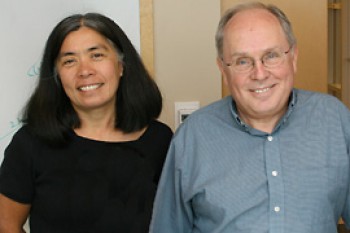Ph.D. - Computer Science
Pennsylvania State University - 1971
Professional Preparation
M.S. - Mathematics
California State University at Hayward - 1967
California State University at Hayward - 1967
B.S. - Mathematics
California State Polytechnic University at San Luis Obispo - 1966
California State Polytechnic University at San Luis Obispo - 1966
Research Areas
Research Interests
- Telecommunication networks
- Parallel computation networks
- Algorithms
- Complexity classes
- Picture processing
- Automata theory
- Graph/network algorithms
- Combinatorial problems
- Computational biology
- Information security
Publications
A quadratic time 2-approximation algorithm for block sorting.
Wolfgang W. Bein, Lawrence L. Larmore, Linda Morales, Ivan Hal Sudborough
Theor. Comput. Sci. 01/2009; 410:711-717. 2009 - Publication
An (18/11)n upper bound for sorting by prefix reversals.
Bhadrachalam Chitturi, William Fahle, Z. Meng, Linda Morales, C. O. Shields Jr, Ivan Hal Sudborough, Walter Voit
Theor. Comput. Sci. 01/2009; 410:3372-3390. 2009 - Publication
An (18/11)n Upper Bound for Sorting by Prefix Reversals, (with B. Chitturi, W. Fahle, Z. Meng, L.Morales, C. O. Shields, W. Voit), invited, submitted, and accepted for publication in the special issue of Theoretical Computer Science to appear in honor of Burkhard Monien (2007). 2007 - Publication
Short Proofs for Cut-and-Paste Sorting of Permutations (with D. Cranston, D. West), Discrete Mathematics, 307 (2007), pp. 2866-2870. 2007 - Publication
The sequential sum problem and performance bounds on the greedy algorithm for the on-line Steiner problem. (with Z. Miller, M. Perkel, D. Pritikin) Networks 45 (3), pp. 143-164 (2005). 2005 - Publication
Combinatorial Optimization of Multicast Key Management, (with L. Morales, M. H. Heydari and M. J. Eltoweissy), Journal of Network and Systems Management, special issue on Security and Management, March 2004, pp. 32-50, Kluwer, New York. 2004 - Publication
Embedding a Complete Binary Tree into a 3-Dimensional Grid, (with W. Bein, L. Larmore, and C. Shields), Journal of Interconnection Networks 5 (2), pp. 111-130 (2004). 2004 - Publication
Block Sorting is Hard (with Wolfgang Bein, Larry Larmore, Sharom Latifi) International Journal of Foundations of Computer Science, 14 (3) (2003), pp. 425-437. 2003 - Publication
Appointments
Distinguished Visiting Professor
Miami University of Ohio [1998–1999]
Miami University of Ohio [1998–1999]
Distinguished Visiting Professor
Miami University of Ohio [1991–1991]
Miami University of Ohio [1991–1991]
Distinguished Visiting Professor
The University of Victoria [1988–1988]
The University of Victoria [1988–1988]
Founders Professor
The University of Texas at Dallas [1985–Present]
The University of Texas at Dallas [1985–Present]
Fullbright Senior Research Professor
National Technical University of Greece [1982–1983]
National Technical University of Greece [1982–1983]
Visiting Professor
University of Paderborn [1979–1980]
University of Paderborn [1979–1980]
Professor
Northwestern University [1971–1985]
Northwestern University [1971–1985]
Additional Information
Teaching Honors
- One of the finalists for the University of Texas Chancellors Teaching Excellence Award in 1997
- Consistently received top teaching evaluations in Erik Jonsson School of Engineering and Computer Science, University of Texas at Dallas (1985-)
- One of the finalists for the University of Texas Chancellors Teaching Excellence Award in 1992
- Teaching Extraordinaire Award, awarded by graduate students in Compiler Construction (1988)
- Teaching Award (Honorable Mention), Technological Institute, Northwestern University, 1977
News Articles
Computer Scientists Make Progress on Math Puzzle
 Two UT Dallas computer scientists have made progress on a nearly 4-decade-old mathematical puzzle, producing a proof that renowned Stanford computer scientist Don Knuth called “amazing” in his communication back to them. Created by the mathematician John Conway and known as Topswops, the puzzle starts like this: Begin with a randomly ordered deck of cards numbered 1 to n, with n being however high a number you choose. Now count out the number of cards represented by whatever card is the top card, and turn that block of cards over on top of the remaining cards. Then count out the number of cards represented by the new top card and turn this whole block over on top of the remaining cards. Repeat until the card numbered 1 comes to the top (realizing that we know the card numbered 1 will always eventually come to the top).
Two UT Dallas computer scientists have made progress on a nearly 4-decade-old mathematical puzzle, producing a proof that renowned Stanford computer scientist Don Knuth called “amazing” in his communication back to them. Created by the mathematician John Conway and known as Topswops, the puzzle starts like this: Begin with a randomly ordered deck of cards numbered 1 to n, with n being however high a number you choose. Now count out the number of cards represented by whatever card is the top card, and turn that block of cards over on top of the remaining cards. Then count out the number of cards represented by the new top card and turn this whole block over on top of the remaining cards. Repeat until the card numbered 1 comes to the top (realizing that we know the card numbered 1 will always eventually come to the top).
